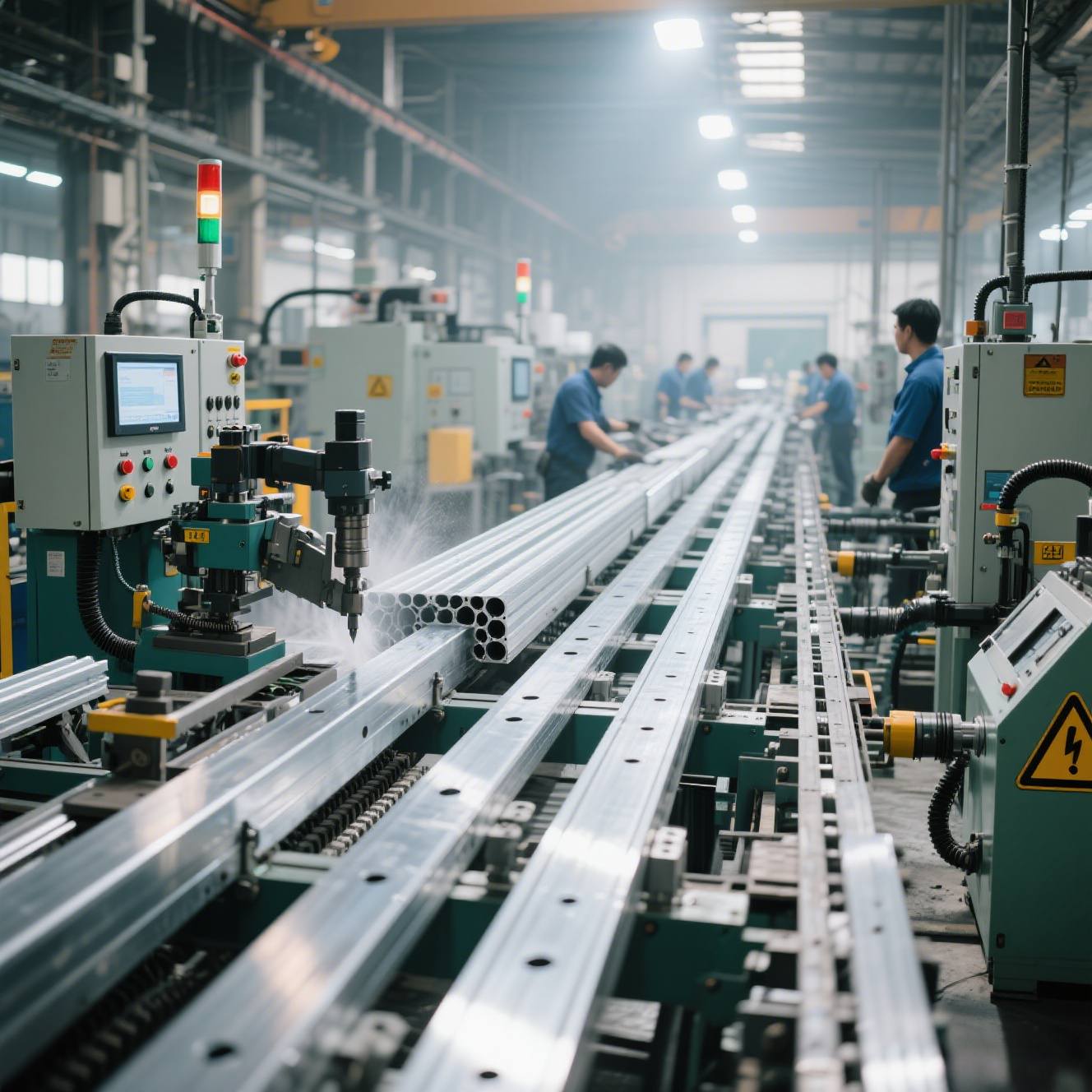
Field-tested Picks: Best Aluminum Screws For Each Application Aluminum Screws Fundamentals That Matter What are aluminum screws and when to use them? Ever wondered why engineers and manufacturers reach for aluminum screws in so many modern projects? Aluminum screws are threaded fasteners made from high-grade aluminum alloys like 6061-T6 or 7075. They’re designed to join components where weight savings, corrosion resistance, and electrical conductivity are essential. You’ll notice these fasteners in aerospace, automotive, electronics, and marine industries, where every gram matters and harsh conditions are the norm. Compared to traditional steel or stainless steel screws, aluminum fasteners offer a unique blend of properties that make them invaluable for specific applications. So, when should you choose aluminum screws over alternatives? Imagine you’re assembling a lightweight drone, a laptop chassis, or a coastal structure. In these scenarios, the benefits of aluminum—being up to 60% lighter than stainless steel and naturally corrosion-resistant—shine through. Their nonmagnetic nature makes them ideal for sensitive electronics, while their thermal and electrical conductivity supports specialized engineering needs. However, keep in mind that aluminum screws are best suited for non-structural or lightly loaded joints, as their tensile strength is lower than that of most steel fasteners. Aluminum versus stainless and carbon steel basics Sounds complex? Let’s break down the key differences at a glance: Material Density (g/cm³) Typical Tensile Strength (MPa) Corrosion Resistance Aluminum 2.7 310–550 Excellent (forms protective oxide layer) Stainless Steel 7.8 500–800 Very Good (but galvanic risk with aluminum) Carbon Steel 7.8 400–600 Moderate (requires coating for corrosion protection) As you can see, aluminum fasteners are roughly one-third the density of steel, making them a top pick for weight-sensitive assemblies. They naturally resist corrosion by forming an oxide layer, which is a big plus in marine or humid environments. However, their tensile strength is lower—so for high-load structural joints, a steel or stainless alu bolt may be more appropriate. Aluminum is also nonmagnetic and easier to machine, which is why it’s so common in electronics and custom assemblies. Common head and drive types for efficient assembly Choosing the right head and drive style can make your assembly process faster and more reliable. Here’s a quick guide: Pan Head (Phillips/Slotted): General-purpose for electronics and sheet metal; easy to drive, good for thin materials. Flat Head: Sits flush with surface, ideal for countersunk holes in aluminum panels. Button Head: Low-profile, smooth finish—great for visible surfaces where snagging is a concern. Socket Head (Hex): High torque capability, best for machine assembly and deep-set applications. Torx: Resists cam-out, perfect for automated assembly and aluminum tapping where precision matters. Aluminum machine screws ar...
Read More
Aluminum Extrusion Profiles: RFQ Template, Costs, Supplier Picks Foundations of Aluminum Extrusion Profiles What Are Aluminum Extrusion Profiles? Ever wondered how lightweight window frames or modular machine guards get their unique shapes and strength? The answer lies in aluminum extrusion profiles. Imagine squeezing toothpaste through a shaped nozzle—aluminum extrusion works in a similar way. Heated aluminum billets are forced through a custom die, producing continuous lengths with a consistent cross-section. This process allows manufacturers to create a vast array of aluminum extrusion shapes—from simple bars to intricate T-slots—tailored for specific engineering needs. Billet: A solid cylinder of aluminum alloy, heated and pressed through a die. Die: A precision tool that shapes the aluminum as it’s extruded. Temper: The heat treatment state of aluminum, affecting strength and flexibility. T-slot: A groove in the profile, ideal for modular assembly and mounting accessories. Anodizing: An electrochemical process that increases corrosion resistance and allows for colored finishes. Extruded Aluminum vs Rolled or Machined Why choose extrusion over other forming methods? Extruded aluminum profiles offer several advantages: Complexity: Extrusion enables the creation of highly complex, seamless shapes in one step—something that would be difficult or costly to achieve by rolling or machining. Continuous Lengths: The process favors long, uninterrupted pieces, reducing the need for joints or welds in frames and enclosures. Customization: With a wide selection of aluminum extrusion types and dies, profiles can be tailored for specific mechanical, architectural, or thermal roles. Standard Profile Families and Uses Not all aluminum profiles are created equal. Here’s a simple breakdown of the main aluminum extrusion sizes and types you’ll encounter in 2025: Profile Type Advantages Typical Applications Solid High strength, simple geometry, low cost Support bars, mounting posts Semi-hollow Balance of strength and weight, allows for cable routing Architectural trim, light-duty frames Hollow Superior stiffness-to-weight, ideal for long spans Window frames, conveyor rails T-slot Modular, easy assembly, flexible mounting Machine frames, workstations, enclosures Popular series like 2020 aluminum extrusion (20x20mm), 3030, and 4040 offer standardized slot widths and geometries for modular construction. Choose 2020 for lightweight machine guards, 3030 for mid-size automation frames, and 4040 when you need maximum rigidity or to span longer distances. Why Aluminum Outshines Steel Corrosion Resistance: Aluminum forms a natural oxide layer, protecting it from rust—even outdoors. Lightweight: At roughly one-third the weight of steel, aluminum profiles are easier to handle and install. Speed of Assembly: Modular T-slot systems enable rapid, tool-less assembly and reconfiguration. Lifecycle Cost: Lower shipping, installation, and maintenance costs over time. And when it ...
Read More
Aluminum C Channel Spec Kit: Cut to Size, Standard, Custom Aluminum C Channel Fundamentals What Is an Aluminum C Channel? When you’re looking for a structural profile that balances strength, weight, and versatility, the aluminum c channel is a go-to choice for engineers and builders alike. But what exactly is it? Simply put, an aluminum c channel is an extruded, open-section profile shaped like the letter “C.” This means it has a flat middle section—called the web—with two parallel extensions on one side, known as flanges. The inside corners often feature a radius for added strength and easier fitment. Most c channel aluminum profiles are produced using the extrusion process: heated aluminum is pushed through a shaped die, resulting in consistent, precise cross-sections. This allows for a range of sizes and wall thicknesses, making it easy to tailor the channel to your project’s needs. “C channels deliver accessible flanges for fastening while minimizing weight.” C vs U vs L vs Box Tube: How Do They Compare? Ever wondered why there are so many aluminum channel shapes? Each profile is designed for specific performance characteristics and installation needs. Here’s a quick guide to the most common shapes you’ll encounter in 2025 projects: C Channel: Open on one side, with two flanges for easy access and fastening. Best for framing, cable runs, and mounting panels. U Channel: Similar to C, but both flanges are parallel and typically of equal length. Good for protective edges and simple frames. L (Angle) Channel: Shaped like an "L," providing corner reinforcement and edge protection. Z Channel: Zig-zag profile, ideal for hanging or mounting panels using Z-clips. Box Tube: Closed rectangular profile, offering maximum torsional rigidity and strength for heavy-duty structural needs. Top Use Cases Engineers Choose in 2025 Why do engineers keep coming back to c aluminum channels? The answer lies in their adaptability and performance across industries: Architectural framing: Clean lines and easy panel mounting for windows, doors, and curtain walls. OEM and machinery: Reliable support for conveyor systems, machine guards, and modular assemblies. Transportation: Lightweight support structures in vehicles, trailers, and rail. Solar and energy: Mounting rails and cable management for solar panels and electrical enclosures. Marine: Corrosion-resistant framing for docks, boats, and walkways. Compared to heavier steel options, extruded aluminum channel profiles offer a superior strength-to-weight ratio and natural corrosion resistance. This makes them ideal for applications where reducing weight, simplifying installation, and minimizing maintenance are key priorities. Key Selection Criteria for Your Project Before you choose an alum c channel, ask yourself: Load path: What forces will the channel need to support? Span and deflection: How far does it need to stretch without bending? Environment: Will it face moisture, chemicals, or temperature swings? Finish requi...
Read More
1/8 Inch Aluminum Sheet: 6061-T6 vs 5052-H32 - Choose Wisely What 1/8 Inch Aluminum Sheet Means in Practice Ever wondered why the 1/8 inch aluminum sheet is such a staple in fabrication shops and design studios? Imagine a material that strikes the perfect balance between strength, weight, and workability—right in the sweet spot for versatility. Let’s break down what makes this 0.125-inch (3.175 mm) aluminum sheet so useful, how it fits into the aluminum sheet metal family, and where it delivers the most value. What 0.125 Inch Thickness Really Means When you see “1/8 inch aluminum sheet,” you’re looking at a thickness of exactly 0.125 inches, which converts to 3.175 mm for metric users. This thickness is right between thinner options like 0.063 inch (1.6 mm) and heavier-duty choices like 3/16 inch (4.76 mm). Why does that matter? At 1/8 inch, you gain a noticeable boost in rigidity and vibration damping while still keeping the sheet light enough for easy handling and fabrication. The density of aluminum means that a full-size 4x8 aluminum sheet at this thickness is substantial but manageable for one or two people to move, depending on alloy and size. Thickness (in) Nominal Metric (mm) Typical Tolerance (ASTM B209) 0.125 3.175 ±0.005 to ±0.015 Sheet Versus Plate for Structural and Fabrication Needs Sounds complex? Here’s a simple distinction: aluminum “sheet” typically refers to material up to 0.249 inches thick, while “plate” starts at 0.25 inches and up. The 1/8 in aluminum sheet sits comfortably in the sheet category, making it ideal for applications that need some structure but not the full heft of plate. Compared to thinner gauges, 1/8 inch offers much greater resistance to bending and flexing, making it a top pick for panels, guards, and brackets where stiffness is key. But it’s still thin enough for most common cutting and forming methods—think shearing, sawing, routing, or even waterjet. Common Sizes and Tempers You Will See Looking for the right fit? Most suppliers stock 1 8 inch aluminum sheet in industry-standard sizes and popular tempers. Here’s what you’ll typically encounter: Standard Sizes: 4x8 ft, 5x10 ft, custom cuts available Tempers: H32 (work-hardened), T6 (heat-treated) Finishes: Mill finish, brushed, anodized, powder-coated For specialty uses, you might also see perforated or decorative options, as well as cut-to-size offerings to minimize waste and simplify handling. These standards are referenced to ASTM B209, ensuring consistent thickness and flatness across suppliers. Best Fit Applications at 1/8 Inch So, where does a 1/8 aluminium sheet really excel? The answer: anywhere you need a combination of moderate strength, light weight, and good formability. You’ll notice it’s a go-to for: Machine guards and safety covers Panels and architectural cladding Brackets, small enclosures, and trays Trailer skins and RV panels Signage and display boards It’s also a favorite for custom fabrication—bending, welding, and forming complex sh...
Read More
1/4 Aluminum Plate: Alloy Picks, Weights, and Cut-ready Tips Quarter inch plate fundamentals you can trust When you’re choosing materials for a project that demands strength and reliability, it’s easy to get lost in the details. Is a metal sheet enough, or do you need something tougher? That’s where the 1/4 aluminum plate stands out—a workhorse in the world of metals, prized for its blend of rigidity, weight, and versatility. But what exactly sets it apart, and how do you know it’s the right call for your next build? What is 1/4 Aluminum Plate? The term "1/4 aluminum plate" refers to an aluminum product with a thickness of exactly 0.250 inch (6.35 mm). According to industry standards, any aluminum product at or above this thickness is classified as a plate, while anything thinner is considered sheet metal. This distinction is important because aluminum plate offers significantly greater stiffness and load capacity compared to sheet, making it ideal for structural and heavy-duty applications. When load-bearing strength and rigidity matter, choose plate over sheet—especially for demanding structural or industrial builds. Common Sizes and Tempers in 2025 In today’s market, the most common format for quarter inch aluminum plate is the 4x8 foot sheet, though cut-to-size blanks are widely available for custom projects. You’ll also find typical tempers like 6061-T6—well-known for its strength and machinability—and 5052-H32, valued for its corrosion resistance and formability. These tempers refer to the material’s heat treatment and mechanical properties, which directly impact how the 1/4 inch aluminum plate performs in real-world conditions. When specifying aluminum plates for critical applications, it’s standard practice to require compliance with ASTM B209. This specification covers both aluminum plate and sheet, ensuring uniformity in thickness, flatness, and mechanical properties across suppliers (ASTM B209). Typical Use Cases by Industry Why is the 1 4 aluminum plate so popular across industries? Imagine you’re designing a machine base, a marine bracket, or a chassis panel—the kind of parts that simply can’t flex or deform under load. The extra thickness of a quarter inch plate delivers the stiffness and reliability engineers count on. Here are some of the most common applications: Machine bases and mounting plates Marine brackets and structural components Chassis panels and automotive bodywork Jigs, fixtures, and tooling plates Architectural supports and sign panels Heavy-duty enclosures and equipment guards In 2025, industries ranging from marine and transportation to aerospace, automation, and architectural fabrication all rely on quarter inch aluminum plate for its unique combination of workability and strength. As you plan your next project, remember that the right choice of alloy, certification, and cutting method will make a big difference in both cost and performance. For those seeking a reliable source of certified stock and cut-to-size se...
Read More online service
online service 0086 136 3563 2360
0086 136 3563 2360 sales@sxalu.com
sales@sxalu.com +86 136 3563 2360
+86 136 3563 2360